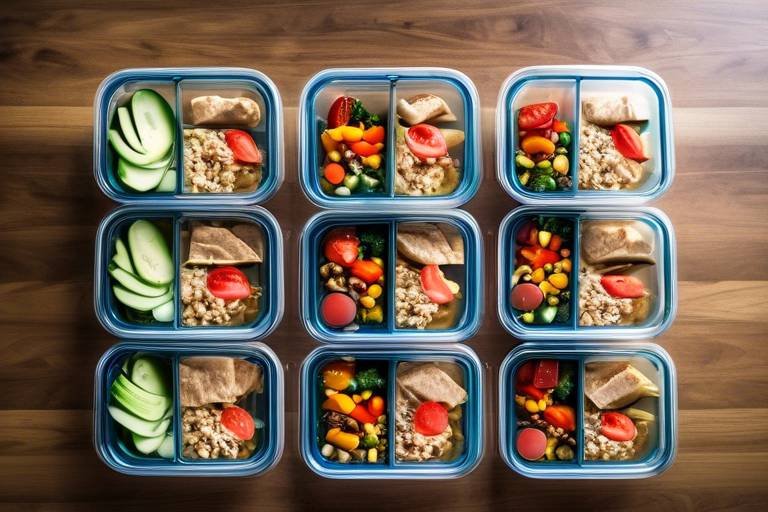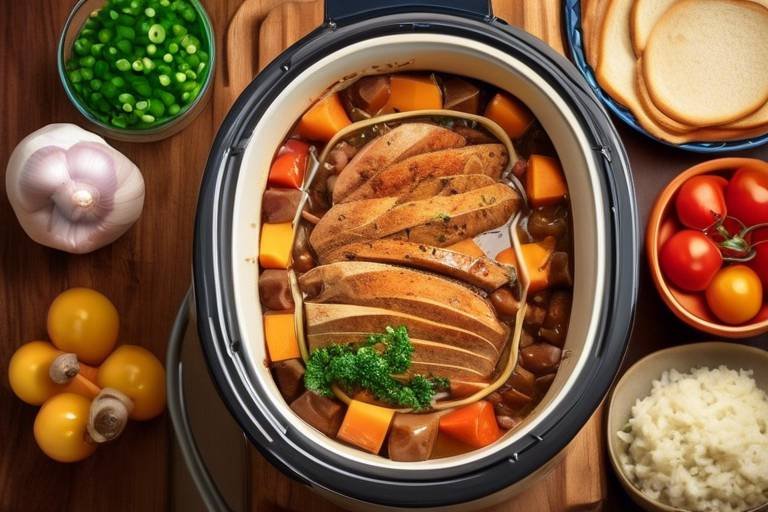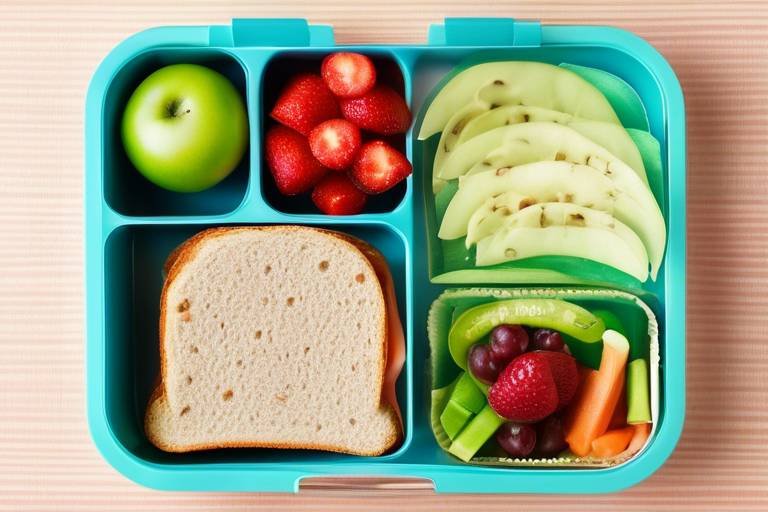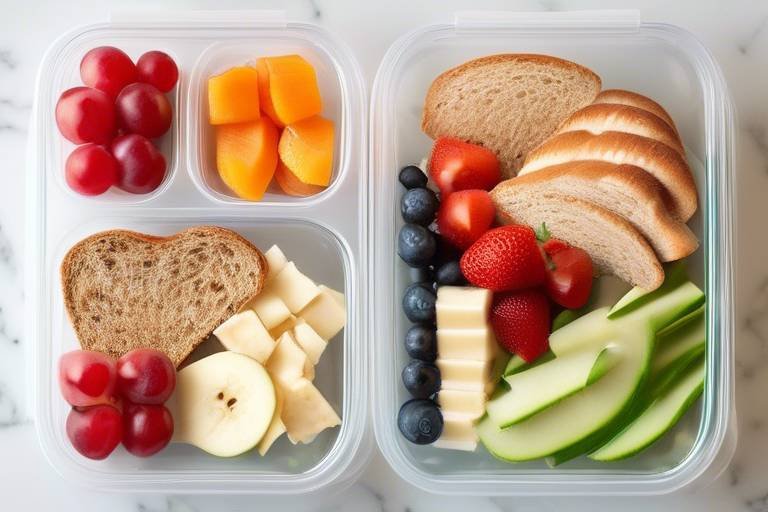Meal Planning Tips for Busy Moms
Being a mom is a full-time job in itself, and when you throw in the added responsibility of meal planning, it can feel like you’re juggling flaming swords! But fear not, because this article provides practical and efficient meal planning tips tailored for busy moms. Our goal is to help you save time and reduce stress while ensuring that your family enjoys healthy and delicious meals. After all, who says you can’t have it all? With a bit of organization and creativity, you can whip up meals that not only satisfy your family’s hunger but also keep them excited about what’s for dinner.
Before diving into meal planning, it’s essential to understand your family’s unique dietary preferences and nutritional requirements. This isn’t just about choosing what’s easy; it’s about creating a meal plan that caters to everyone’s tastes and health needs. Start by assessing what your family enjoys eating. Do your kids love pasta, or are they more into tacos? Are there any allergies or dietary restrictions to consider? Engaging your family in this process can make meal planning a fun activity rather than a chore. You might even discover some hidden culinary preferences! Remember, the more personalized your meal plan is, the more likely your family will enjoy the meals you prepare.
A structured meal schedule can be a game changer for busy moms. It streamlines your cooking process and helps you avoid the dreaded “What’s for dinner?” panic. To design a weekly meal plan that accommodates your family’s routine, start by taking a look at your calendar. Do you have soccer practice on Tuesdays or family movie night on Fridays? Factor these activities into your meal planning. You might choose to prepare quick meals on busy days and save more elaborate recipes for weekends. This way, grocery shopping becomes a breeze because you’ll know exactly what you need for the week ahead!
Keeping meals interesting is essential for family enjoyment. Nobody wants to eat the same thing every night, right? To spice things up, try incorporating a variety of ingredients and cuisines into your weekly meal plans. Think of it like a culinary adventure! One week, you could explore Mediterranean flavors with dishes like falafel and tzatziki, while the next week, you could dive into Asian cuisine with stir-fries and sushi rolls. Don’t hesitate to experiment with different herbs, spices, and cooking methods. This not only keeps your family excited about dinner but also exposes them to new flavors and cultures.
Utilizing seasonal produce is a fantastic way to enhance flavor and support local farmers. When fruits and vegetables are in season, they’re not only fresher but often more affordable. For example, summer is the perfect time for juicy tomatoes and sweet corn, while fall brings pumpkins and hearty squash. Incorporating seasonal ingredients into your meal planning not only boosts the taste of your dishes but also helps you save money. Plus, it’s a great way to teach your kids about the importance of eating fresh and supporting local agriculture!
Batch cooking can be a lifesaver for busy families. Imagine spending a couple of hours on the weekend prepping meals that will last you throughout the week! It’s like having a personal chef at your disposal. Consider preparing large quantities of staples like rice, quinoa, or roasted vegetables that can be used in various dishes. You can also cook up big pots of soups or stews that can be portioned out and frozen for later. This way, when those hectic weeknights roll around, you’ll have delicious, homemade meals ready to go in no time!
Leftovers can be a lifesaver for busy families, and finding innovative ways to repurpose them can minimize waste and maximize time efficiency in the kitchen. For instance, if you have leftover roasted chicken, you can transform it into chicken tacos, a hearty soup, or even a salad the next day. Get creative with your leftovers! Not only does this save time, but it also ensures that you’re making the most out of your grocery budget. Who doesn’t love a good two-for-one deal?
Efficient grocery shopping is key to successful meal planning. To make your shopping trips quicker and more effective, start by creating organized shopping lists. Group items by category—produce, dairy, meats, etc.—to save time as you navigate the store. Additionally, consider utilizing store sales and discounts. Many grocery stores offer weekly flyers that highlight sales, so keep an eye out for your family’s favorite items. This way, you can stock up on essentials without breaking the bank!
Staying within budget is important for many families, and grocery shopping doesn’t have to be a financial burden. Here are some tips for budget-friendly grocery shopping:
- Use Coupons: Look for coupons in newspapers, apps, or store websites.
- Buy in Bulk: Purchasing items in bulk can save you money over time.
- Choose Store Brands: Often, store brands are just as good as name brands but come at a lower cost.
By implementing these strategies, you can keep your grocery expenses in check while still providing nutritious meals for your family.
With busy schedules, online grocery shopping can be a game-changer. Many families are discovering the convenience of ordering groceries online and having them delivered right to their door. This not only saves time but also allows you to avoid impulse purchases that can happen when you’re wandering the aisles. Plus, you can easily compare prices and find the best deals without leaving your home! If you haven’t tried it yet, it might just be the solution you didn’t know you needed.
Q: How can I get my kids involved in meal planning?
A: Involve your kids by letting them choose a meal for the week. You can also have them help with grocery shopping or cooking, making it a fun family activity!
Q: What are some quick meal ideas for busy nights?
A: Consider meals like stir-fries, pasta dishes, or tacos, which can be prepared in 30 minutes or less. Keep your pantry stocked with quick-cooking grains and frozen veggies for easy meals.
Q: How can I avoid food waste?
A: Plan your meals around what you already have in your pantry, utilize leftovers creatively, and consider freezing excess food to use later.

Understanding Your Family's Needs
Meal planning is more than just jotting down what to cook for dinner. It’s about understanding your family's unique dietary preferences and nutritional needs. Every family is different, and what works for one might not work for another. So, how do you figure out what your family really needs? Start by having a conversation with your family members. Ask them about their favorite foods, any dietary restrictions, and what meals they absolutely love. This not only helps you gather insights but also makes them feel included in the meal planning process.
For instance, if someone in your family is a vegetarian or has allergies, it’s crucial to incorporate alternatives that cater to those needs. You can create a simple table to track these preferences:
| Family Member | Dietary Preferences | Allergies |
|---|---|---|
| Mom | Vegetarian | N/A |
| Dad | Meat Lover | Nuts |
| Child 1 | Gluten-Free | N/A |
| Child 2 | Standard | Dairy |
By maintaining a clear understanding of each member's needs, you can ensure that your meal plans are not only delicious but also nutritionally balanced. Additionally, consider keeping a list of meals that cater to these preferences. This can serve as a reference point when planning your weekly menu.
Another effective strategy is to observe any patterns in your family's eating habits. Are there days when everyone is too busy to sit down for a meal? Recognizing these trends can help you plan easier, quick-prep meals on those hectic days. Think of it as creating a personalized meal map that guides you through your family's culinary landscape.
Finally, don't forget to be flexible! Life is unpredictable, and sometimes your carefully crafted meal plan may need to change. Having a list of go-to meals that can be prepared quickly or on-the-fly will save you from stress and help you stay on track. Remember, the goal is to create a meal plan that not only nourishes but also brings joy to your family’s dining experience.
- How do I handle picky eaters? Engaging them in the meal planning process can help. Let them choose a dish or two each week.
- What if I have a tight budget? Focus on seasonal ingredients and plan meals around sales to maximize your grocery budget.
- How can I ensure my family eats healthy? Incorporate a variety of fruits, vegetables, whole grains, and lean proteins in your meal plans.

Creating a Weekly Meal Schedule
When it comes to meal planning, having a structured approach is like having a roadmap for your week. It not only saves you time but also helps you maintain a sense of control over what your family eats. So, how do you go about creating an effective weekly meal schedule? First, you’ll want to consider your family’s routine. Do you have busy evenings filled with activities, or is there a day when everyone is home and can enjoy a sit-down dinner? Understanding these dynamics will help you design a plan that works for everyone.
Next, think about meal prep days. Many busy moms find that setting aside a couple of hours on the weekend to prepare meals can make weekdays much smoother. For instance, you could cook a big batch of spaghetti sauce on Sunday and use it for different meals throughout the week. This not only saves time but also reduces the stress of figuring out what to cook each night. Consider creating a simple table to visualize your meal prep:
| Day | Meal | Prep Time |
|---|---|---|
| Monday | Spaghetti with Marinara | 30 mins |
| Tuesday | Taco Night | 20 mins |
| Wednesday | Stir-Fried Veggies and Chicken | 25 mins |
| Thursday | Leftover Spaghetti | 10 mins |
| Friday | Pizza Night | 15 mins |
| Saturday | Grilled Cheese and Tomato Soup | 15 mins |
| Sunday | Family BBQ | 1 hr |
Another tip is to incorporate a theme for each day. This can make meal planning feel more fun and less daunting. For instance, you might designate Mondays as “Meatless Mondays,” where you focus on vegetarian meals, or Fridays as “Fun Food Fridays,” where you can experiment with different cuisines. This not only keeps things interesting but also encourages your family to try new things.
Don’t forget to involve your family in the planning process! Ask your kids what meals they enjoy and see if they can help choose one or two meals each week. This not only makes them feel included but can also spark excitement around mealtime. Plus, when kids are involved in the decision-making, they are often more willing to eat what’s on their plate.
Lastly, always keep a running grocery list as you create your weekly meal schedule. This should include all the ingredients you need for the meals you plan to prepare. By having a dedicated list, you’ll find grocery shopping becomes a breeze, and you’ll minimize the chances of forgetting crucial items. Remember, a well-thought-out meal schedule can transform your week from chaotic to calm, allowing you to spend more quality time with your family.
Q: How do I know what meals to plan?
A: Start by assessing your family’s favorite meals and dietary restrictions. You can also look for inspiration online or in cookbooks.
Q: How can I make meal prep easier?
A: Consider preparing ingredients in bulk, using simple recipes, and involving your family in the cooking process.
Q: What if my schedule changes during the week?
A: Be flexible! If plans change, try to swap meals around or have a few easy backup options available.

Incorporating Variety
When it comes to meal planning, one of the biggest challenges busy moms face is keeping meals exciting. Let's be honest: no one wants to eat the same thing every night! Incorporating variety into your family meals doesn't just make dinner more enjoyable; it also ensures that everyone gets a balanced diet filled with different nutrients. So, how can you spice things up in the kitchen without spending hours planning? Here are some practical tips to help you get started.
First, consider diversifying your protein sources. Instead of relying solely on chicken or ground beef, explore options like fish, legumes, tofu, or even game meats. Each protein brings its own unique flavor and nutritional profile. For instance, while chicken is a great source of lean protein, beans and lentils are packed with fiber and can be used in a variety of dishes, from soups to salads. This not only keeps your meals interesting but also introduces your family to new tastes and textures.
Another way to mix things up is by experimenting with different cuisines. Why not have a themed dinner night each week? One week could be Italian with homemade pasta and marinara sauce, while another could be Mexican with tacos and guacamole. This not only makes meal planning fun but also gives your family a chance to learn about different cultures through food. You could even create a simple table like this to plan your themed nights:
| Week | Cuisine | Dishes |
|---|---|---|
| 1 | Italian | Pasta, Pizza, Tiramisu |
| 2 | Mexican | Tacos, Enchiladas, Churros |
| 3 | Asian | Sushi, Stir-fry, Dumplings |
| 4 | American | Burgers, BBQ, Apple Pie |
Don't forget to rotate your vegetables as well! Seasonal produce can add a fresh twist to your meals. For example, in the summer, you might find yourself enjoying grilled zucchini and corn, while in the fall, roasted butternut squash and Brussels sprouts can steal the show. Incorporating seasonal ingredients not only enhances flavor but also supports local farmers and can be more cost-effective. Plus, your kids will love seeing the vibrant colors on their plates!
Lastly, consider involving your family in the meal planning process. Ask your kids for their input on what they’d like to eat. This not only makes them feel included but also gives you insight into their preferences. You might be surprised to find out that your little ones have a taste for something adventurous! By making it a family affair, you can create a meal plan that everyone looks forward to, reducing the chances of complaints at the dinner table.
Incorporating variety into your meal planning doesn't have to be complicated or time-consuming. With a little creativity and a willingness to try new things, you can keep your family's meals exciting and nutritious. So, roll up your sleeves, grab your apron, and let the culinary adventure begin!
- How can I ensure my family gets a balanced diet? Focus on including a variety of proteins, vegetables, grains, and fruits in your meals. Rotate different ingredients each week to cover all food groups.
- What are some easy ways to introduce new cuisines? Start with simple recipes that are easy to make, and gradually explore more complex dishes. Themed dinner nights can also help make this process fun!
- How can I get my kids to eat more vegetables? Involve them in meal prep, let them pick out vegetables at the store, and try different cooking methods. Making veggies visually appealing can also help!

Seasonal Ingredients
Utilizing in your meal planning can transform your family dinners from ordinary to extraordinary. Imagine biting into a juicy, sun-ripened tomato in the summer or savoring the warmth of a hearty squash soup in the fall. These ingredients not only taste better, but they also come packed with nutrients at their peak ripeness. By choosing what’s in season, you’re not just enhancing the flavor of your meals; you’re also supporting local farmers and reducing your carbon footprint. It’s a win-win!
So, how do you get started? First, consider creating a seasonal produce calendar to help you know what to look for each month. This way, you can plan your meals around fresh fruits and vegetables that are at their best. For example, in the spring, you might enjoy asparagus, peas, and strawberries, while the fall can bring you pumpkins, apples, and root vegetables. Here’s a simple table to illustrate some seasonal ingredients:
| Season | Fruits | Vegetables |
|---|---|---|
| Spring | Strawberries, Rhubarb | Asparagus, Spinach |
| Summer | Tomatoes, Peaches | Zucchini, Bell Peppers |
| Fall | Apples, Pears | Squash, Carrots |
| Winter | Citrus Fruits, Pomegranates | Root Vegetables, Kale |
When you incorporate these seasonal ingredients into your meals, you’ll not only enjoy vibrant flavors but also save money. Seasonal produce is often less expensive than out-of-season items because it doesn’t have to be shipped from far away. Plus, you can get creative in the kitchen! Try making a summer salad with fresh tomatoes, basil, and mozzarella, or whip up a comforting autumn stew with root vegetables and herbs. The possibilities are endless!
Finally, don’t forget to involve your family in the process. Take them to the local farmers' market, where they can see, touch, and taste the fresh produce. This not only makes shopping fun but also helps kids learn about where their food comes from, fostering a greater appreciation for healthy eating. So, the next time you sit down to plan your meals, remember to look to the season for inspiration. It’s a simple change that can lead to delicious and nutritious results!
- What are the benefits of using seasonal ingredients? Seasonal ingredients are fresher, tastier, and often more affordable. They also support local agriculture.
- How can I find out what's in season? You can check online seasonal produce calendars or visit local farmers' markets for guidance.
- Are there any specific recipes you recommend for seasonal cooking? Absolutely! Consider trying a summer ratatouille or a winter root vegetable mash.

Batch Cooking Ideas
Batch cooking is a **game changer** for busy moms juggling the chaos of daily life. Imagine having a week’s worth of meals ready to go, just waiting for you in the fridge or freezer. It’s like having a personal chef at your disposal! By setting aside a few hours on the weekend or whenever you have a spare moment, you can prepare multiple meals at once, saving you time and stress during the week. Plus, it allows you to enjoy **homemade** meals without the hassle of daily cooking.
One effective approach to batch cooking is to choose a few versatile base ingredients that can be used in various dishes. For instance, you might cook a large batch of quinoa, brown rice, or pasta. These can serve as the foundation for different meals throughout the week. Pair them with a variety of proteins, such as grilled chicken, beans, or tofu, and you have the makings of multiple dinners. You can also create a few different sauces or dressings to keep things exciting. Think of it like building blocks; you can mix and match to create something new each night!
Another fantastic idea is to prepare **freezer-friendly meals**. Dishes like soups, stews, and casseroles freeze exceptionally well. You can make a big pot of chili or a hearty vegetable soup, portion it out into individual servings, and freeze them. On a busy evening, simply grab a container from the freezer, heat it up, and you have a nutritious meal ready in minutes. This not only saves time but also helps reduce food waste, as you can make use of leftover ingredients from your fridge.
Don’t forget about breakfast! Mornings can be hectic, so why not prepare breakfast items in bulk? You could whip up a batch of **overnight oats** or bake a tray of healthy muffins. These can be stored in the fridge or freezer and are perfect for quick grab-and-go options in the morning. Imagine waking up to a delicious muffin or a jar of oats waiting for you—talk about a stress-free start to the day!
To help you visualize your batch cooking plan, here’s a simple table with meal ideas that you can prepare in bulk:
| Meal Type | Batch Cooking Ideas | Storage Tips |
|---|---|---|
| Soups & Stews | Chili, Vegetable Soup, Chicken Noodle Soup | Cool completely before freezing in airtight containers. |
| Casseroles | Lasagna, Mac and Cheese, Enchiladas | Wrap tightly in foil before freezing. |
| Grains | Brown Rice, Quinoa, Pasta | Store in airtight containers in the fridge for up to a week. |
| Breakfast | Overnight Oats, Muffins, Smoothie Packs | Freeze muffins and use jars for oats; smoothies can be blended fresh. |
By incorporating batch cooking into your weekly routine, you can transform your mealtime experience. It’s all about planning and making the most of your time in the kitchen. So, why not give it a shot? You might just find that it’s the secret weapon you need to conquer your busy week while keeping your family happy and well-fed!
Q: How do I start batch cooking?
A: Begin by selecting a few recipes that can be made in large quantities. Set aside a few hours during the weekend to cook and portion the meals into containers for the week ahead.
Q: Can I freeze all types of food?
A: Not all foods freeze well. Foods with high water content, like cucumbers and lettuce, do not freeze well, while soups, stews, and casseroles are excellent candidates for freezing.
Q: How long can I store batch-cooked meals in the freezer?
A: Generally, most cooked meals can be stored in the freezer for up to three months. However, for the best quality, aim to consume them within one to two months.

Utilizing Leftovers Wisely
Leftovers can often feel like a burden, sitting in the fridge and waiting for someone to give them a second chance. But what if I told you that these remnants of yesterday's meals can actually be your best friends in the kitchen? Instead of tossing them out or letting them languish, you can transform them into exciting new dishes that your family will love. Think of leftovers as a treasure chest of culinary possibilities, just waiting to be unlocked!
First off, let's talk about repurposing. Leftover roasted chicken, for example, can quickly become the star of a hearty chicken soup or a flavorful chicken salad. You can even toss it into a stir-fry with some fresh veggies for a quick weeknight dinner. The key here is to think creatively. Instead of viewing leftovers as yesterday's food, see them as the foundation for today's meal.
Another fantastic way to utilize leftovers is through the art of mixing and matching. If you have leftover rice or quinoa, pair it with some sautéed vegetables and a protein for a nutritious bowl. You can even create a fun "leftover night" where everyone gets to choose their favorite items from the fridge and build their own plates. This not only reduces waste but also makes for a fun and interactive dinner experience!
Now, let's not forget about the power of freezing. If you find yourself with more leftovers than you can handle, consider freezing portions for later use. Soups, stews, and casseroles freeze exceptionally well and can be lifesavers on those particularly hectic days when cooking from scratch feels impossible. Just label them with the date and contents, and you'll have a ready-to-eat meal at your fingertips.
To make things even easier, here’s a quick comparison table to illustrate some common leftovers and their potential transformations:
| Leftover | Possible Transformations |
|---|---|
| Roasted Vegetables | Vegetable stir-fry, frittata, or soup |
| Cooked Pasta | Pasta salad, baked pasta, or soup |
| Grilled Chicken | Chicken tacos, salad, or stir-fry |
| Rice or Quinoa | Grain bowls, stuffed peppers, or fried rice |
Incorporating leftovers into your meal planning not only saves time and money but also reduces food waste, making it a win-win situation for busy moms. So the next time you find a container of uneaten food in your fridge, don’t despair! Instead, embrace the challenge and let your creativity shine. Who knows? You might just discover a new family favorite!
Q1: How long can I keep leftovers in the fridge?
A1: Generally, leftovers can be safely stored in the fridge for about 3 to 4 days. Make sure to store them in airtight containers to maintain freshness.
Q2: Can I freeze all types of leftovers?
A2: Most cooked foods freeze well, including soups, stews, and casseroles. However, some items like cooked pasta or rice may lose texture upon thawing, so it's best to consume them fresh when possible.
Q3: What's the best way to reheat leftovers?
A3: The best reheating method depends on the food. Microwaving is quick and easy, but for items like pizza or baked dishes, reheating in the oven can help maintain crispiness. Always ensure food is heated to an internal temperature of 165°F (74°C) for safety.

Smart Grocery Shopping Tips
When it comes to meal planning, efficient grocery shopping is absolutely essential. Imagine walking into a store with a clear plan, knowing exactly what you need and where to find it. This not only saves you time but also helps you avoid impulse buys that can derail your budget. To kick things off, start by creating a well-organized shopping list. This simple tool can be your best friend in the grocery aisle. Consider categorizing your list based on the layout of your favorite store—produce, dairy, meats, and pantry items. By grouping items together, you can navigate the store like a pro, minimizing the time spent wandering the aisles.
Another great tip is to take advantage of store sales and promotions. Most grocery stores have weekly ads that highlight discounts on various items. By planning your meals around these sales, you can significantly cut down on your grocery bill. For instance, if chicken is on sale, consider incorporating it into multiple meals throughout the week. This not only saves money but also reduces the number of different ingredients you need to purchase.
Don't forget to check your pantry and fridge before heading out. It’s easy to forget what you already have on hand, leading to duplicate purchases. By taking inventory, you can make more informed decisions about what to buy, ensuring that you only get what you need. Additionally, consider using a meal planning app or a simple spreadsheet to keep track of your grocery needs and meal ideas. This tech-savvy approach can streamline your shopping experience even further.
Staying within budget is a priority for many families. Here are some effective strategies to keep your grocery costs down:
- Use Coupons: Always check for coupons before you shop. Many stores offer digital coupons that can be easily applied at checkout.
- Buy in Bulk: Purchasing non-perishable items in bulk can lead to significant savings over time.
- Choose Store Brands: Often, store brands are just as good as name brands but come at a fraction of the price.
By implementing these strategies, you can stretch your grocery budget further without sacrificing quality. Plus, who doesn’t love a good deal? It’s like finding a hidden treasure every time you shop!
In today’s fast-paced world, online grocery shopping is becoming increasingly popular, especially for busy moms. Imagine being able to order everything you need from the comfort of your home, avoiding the chaos of the store. Many grocery chains now offer delivery or pickup services that allow you to shop online, add items to your cart, and schedule a convenient time for pickup or delivery. This can be a game-changer for those hectic weeks when you just can’t find the time to go out.
Not only does online shopping save time, but it also helps you stick to your grocery list. Since you’re shopping from home, it’s easier to resist the temptation of impulse buys. Plus, many online grocery services provide recommendations based on your previous purchases, making it simple to restock your favorites without even thinking about it. However, be mindful of delivery fees and minimum purchase requirements, as these can sometimes offset the convenience.
Q: How can I ensure I'm buying healthy foods while grocery shopping?
A: Focus on the perimeter of the store where fresh produce, meats, and dairy are usually located. Try to limit purchases from the processed food aisles.
Q: What should I do if I forget my shopping list?
A: If you forget your list, take a moment to recall the meals you planned for the week. Stick to the basics and try to remember what you need for each meal.
Q: How can I make grocery shopping more enjoyable?
A: Consider making it a family outing. Involve your kids in the shopping process by letting them choose a healthy snack or fruit. This not only makes it fun but also teaches them about healthy eating.

Budget-Friendly Shopping
Shopping on a budget doesn't have to feel like a chore. In fact, with a little planning and some savvy strategies, you can make your grocery trips not only affordable but also fun! First, let’s talk about the importance of setting a budget. Knowing how much you can spend each week helps you make better choices and avoid impulse purchases. It’s like having a roadmap for your grocery shopping adventure!
One of the best ways to stick to your budget is by using coupons. They’re not just for extreme couponers; anyone can benefit from them! Many grocery stores offer digital coupons that you can load directly onto your loyalty card. This way, you can save money without the hassle of clipping paper coupons. Plus, keep an eye out for store sales and weekly specials. Planning your meals around these deals can significantly cut your grocery bill. For instance, if chicken is on sale, consider incorporating it into multiple meals that week.
Another smart strategy is to buy in bulk. Items like rice, pasta, and canned goods often come at a lower price per unit when purchased in larger quantities. Just make sure you have enough storage space at home! You can also choose store brands over name brands. Often, store-brand products are just as good in quality and taste, but they come at a fraction of the price. This can lead to substantial savings over time, especially for staples like milk, bread, and eggs.
To make your shopping experience even more efficient, consider creating an organized shopping list. Before you head out, sit down and plan your meals for the week. Write down all the ingredients you’ll need and group them by category (produce, dairy, etc.). This not only saves time but also helps you avoid buying items you don’t need. Trust me, wandering the aisles without a list can lead to unexpected purchases that can blow your budget!
Lastly, don't underestimate the power of meal prepping. When you prepare meals in advance, you can buy ingredients in bulk and use them efficiently, reducing waste and saving money. You can even turn leftovers from one meal into a completely different dish the next day! For example, roasted vegetables can easily become a delicious stir-fry or a hearty soup. This not only keeps your meals exciting but also stretches your grocery budget further.
By incorporating these budget-friendly shopping tips into your routine, you’ll find that eating healthy and delicious meals for your family doesn’t have to break the bank. Remember, it’s all about being strategic and making informed choices. Happy shopping!
- How can I save money on groceries without using coupons?
Consider buying store brands, shopping sales, and purchasing in bulk. - What are some good budget-friendly meal ideas?
Meals like stir-fries, soups, and casseroles are great for using up leftovers and can be made affordable. - Is it worth it to shop online for groceries?
Yes! Online shopping can save you time and help you stick to your budget by preventing impulse buys.

Online Grocery Options
In today's fast-paced world, online grocery shopping has emerged as a lifesaver for busy moms. Imagine being able to order all your groceries with just a few clicks, all while sipping your coffee in your pajamas! This convenience not only saves time but also allows you to avoid the chaos of crowded stores. With various platforms available, it’s essential to find one that suits your family’s needs.
Many grocery stores now offer online shopping with options for delivery or curbside pickup. This means you can select your items from the comfort of your home and either have them delivered right to your doorstep or pick them up without leaving your car. It's like having a personal shopper who knows your preferences! But how do you choose the right service? Here are some factors to consider:
- Selection: Ensure the service offers a wide range of products, including fresh produce, dairy, and pantry staples.
- Pricing: Compare prices across different platforms to ensure you’re getting the best deal.
- Delivery Fees: Be aware of any additional fees for delivery or pickup services.
- Availability: Check if the service is available in your area and during the times you need it.
One of the most significant advantages of online grocery shopping is the ability to easily compare prices and find sales. Many platforms also allow you to create a shopping list that you can save and reuse, making it even simpler to keep track of what your family needs week after week. Plus, you can often find exclusive online discounts that aren’t available in-store!
Moreover, online grocery shopping can help you stick to your meal plan. When you shop online, you can refer back to your meal schedule and add only the items you need, reducing impulse buys. This not only keeps your budget in check but also minimizes food waste, as you’re more likely to use what you purchase.
However, it’s essential to be mindful of the potential downsides. Sometimes, the quality of fresh produce or meats may not meet your expectations when ordered online. To mitigate this, consider choosing services that allow you to specify preferences for items, like ripe avocados or firm tomatoes. You can also read reviews and ask for recommendations from fellow moms to find the best services.
In conclusion, online grocery shopping is a fantastic option for busy moms looking to simplify their lives. By taking advantage of the convenience, time savings, and budgeting benefits, you can focus more on what truly matters—spending quality time with your family!
1. Is online grocery shopping more expensive than shopping in-store?
While some online services may charge delivery fees, many offer competitive prices and exclusive discounts. It's essential to compare prices to find the best option for your budget.
2. How do I ensure the quality of fresh produce when shopping online?
Choose services that allow you to specify preferences for fresh items, and read reviews from other customers to gauge quality.
3. Can I use coupons when shopping online?
Yes, many online grocery services accept digital coupons. Be sure to check their website or app for available offers!
4. What if I need to make changes to my order?
Most online grocery services allow you to modify your order up until a certain time before delivery or pickup. Always check their policies for specifics.
Frequently Asked Questions
- What are some tips for understanding my family's dietary needs?
To understand your family's dietary needs, start by having open conversations about food preferences and any dietary restrictions. Consider factors like allergies, health conditions, and personal tastes. Keeping a food diary for a week can also help you spot trends in what your family enjoys and what they might be lacking nutritionally.
- How can I create a weekly meal schedule that works?
Creating a weekly meal schedule involves assessing your family's routine and incorporating meals that fit into your busy life. Start by picking a day to plan your meals, then choose dishes that can be easily prepared or batch-cooked. Use a calendar or a meal-planning app to visualize your week, ensuring that you include a mix of proteins, veggies, and grains to keep things balanced.
- What are some ways to incorporate variety in meal planning?
To keep meals exciting, try rotating different cuisines each week or experimenting with new recipes. You can also introduce a "theme night" like Taco Tuesday or Pasta Friday. Don’t forget to include seasonal ingredients, as they can elevate flavors and offer new opportunities for creativity in the kitchen!
- How does batch cooking save me time?
Batch cooking allows you to prepare multiple meals at once, which means less time spent in the kitchen during the week. By cooking larger portions of meals like soups, stews, or casseroles and freezing them, you can simply reheat them on busy nights. This not only saves time but also reduces the temptation to order takeout!
- What are some smart grocery shopping tips?
To make grocery shopping more efficient, always create a shopping list based on your meal plan. Organize the list by store sections to minimize backtracking. Additionally, consider shopping during off-peak hours to avoid crowds and take advantage of store sales and discounts to save money.
- How can I shop for groceries on a budget?
Staying on budget while grocery shopping can be achieved by using coupons, buying in bulk, and opting for store brands instead of name brands. Planning meals around sales and seasonal produce can also help you save significantly while ensuring your family eats well.
- What are the benefits of online grocery shopping?
Online grocery shopping can be a lifesaver for busy moms! It saves time by allowing you to shop from home, avoiding the hassle of navigating the store with kids. Plus, you can easily compare prices, find deals, and even schedule deliveries, making it a convenient option for your family's needs.



















